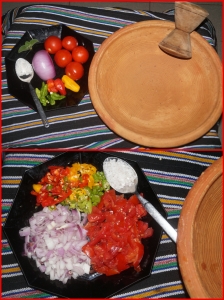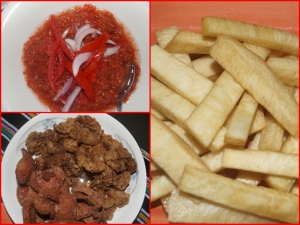In the previous post, I shared on Ghanaian mortars and pestles, specifically the first type within the first group which includes those for grinding ingredients into paste, puree or sauce. I explained that the grinding bowl commonly called the aportoryewa, asanka or kahn and the tapori require a skillful technique of clutching one end of the tapori and crushing the ingredients placed in the center of the mortar by dragging the pestle in linear and circular motions, short distances from the center and back again, all the while exerting pressure.
This technique involves more flexing of the wrist than a movement of the whole arm while the other arm keeps the mortar firmly in place as the grinding progresses. More importantly, the posture assumed by the cook during the use of the aportoryewa and the tapori ensures its efficiency.
The most adopted posture involves sitting on a low stool with the aportoryewa set on the floor, next to the foot (left or right depending on whether the cook is right-handed or left-handed). The floor would be swept clean beforehand and one assumes that the cook would be comfortable with bending over or leaning sideways while sitting.
With the second posture that the Ghanaian cook is likely to adopt in the use of the aportoryewa the mortar is set on a stool or table which comes up to about knee level. The cook sits with the table or stool between the knees, or stands right in front of or to the side of the stool or table during grinding. Personally, this is my preferred posture.
The third posture requires that the aportoryewa be set on a waist-high table or a counter top at arm’s length while the cook stands during grinding. Again, the comfort of the cook must be considered if the aportoryewa is to be efficiently employed in its tasks. These tasks differ; whether in preparing ingredients to be added to a pot of soup or to mash a variety of ingredients into a sauce.
Before the aportoryewa is used for the first time, it is washed and then seasoned by heating it on fire and grinding some coarse salt in it. The salt helps to clear out any clay residue that the initial washing may not have tackled. It’s a bit like seasoning a cast-iron pot before its first use.
There are many local Ghanaian sauces which can be prepared with the help of the aportoryewa and tapori. The pair also prove quite handy when I make sauces that are no where indigenous to me, such as Pesto or Salsa Romescu. That said, I have chosen to demonstrate one main specialty which can be found everywhere in Ghana. In the Akan dialect it is called Merko or Mokow and in the Ga dialect it is referred to as Shitor – names meaning pepper.
It is simply a fresh hot pepper sauce, much like a relish or sambal, made by pulverizing chili peppers, onions, tomatoes and salt together. Sometimes the cook may choose to add garlic, ginger or herbs but this is more the exception than the norm. It can be made hot or mild to taste by controlling the proportion of chilies used, in relation to the other ingredients. Similarly, the texture of the sauce – i.e. how smooth or coarse it is – depends on the cook and what the sauce is to be served with.

All Set to grind: Whole ingredients washed and then chopped; onion, tomatoes, chilies, salt (and the optional sprig of sage).
This kind of sauce is so easy to prepare and it is the first sauce one learns to prepare with the aportoryewa and tapori. The ingredients and utensils are first washed clean. The ingredients are then chopped and ground sequentially, usually beginning with the pepper and adding the others as the grinding progresses. Finally, the sauce is seasoned with salt, dished for table and garnished with sliced tomatoes and onions. Another finishing touch is to top the sauce with some warm seasoned oil (red palm, coconut etc) just before serving.
It can be served as a table condiment or the main sauce in a meal. Traditionally it is the perfect match for kenkey (steamed maize meal dumplings wrapped in corn husks) with fried fish. A popular snack, available even at street level is whole boiled eggs, shelled, split lengthwise and stuffed right down the middle with fresh hot pepper sauce. The sauce can also be served with a mixed fry or mixed grill that accompanies drinks. For example, fried yams or fried sweet potatoes are always served with hot sauce and fish or meat similar to what is shown in the next picture.
These days, the chopped ingredients can be put into a food processor or blender and whizzed to obtain a sauce in no time. However, every true aficionado of traditional Ghanaian cookware swears that fresh pepper sauce made in a blender just can’t compete. So, watch out for the next post, where I will put up a video or two of the aportoryewa and tapori in action!


Pingback: FRESH PEPPER SAUCE – GHANA STYLE. | The Beehive Centre